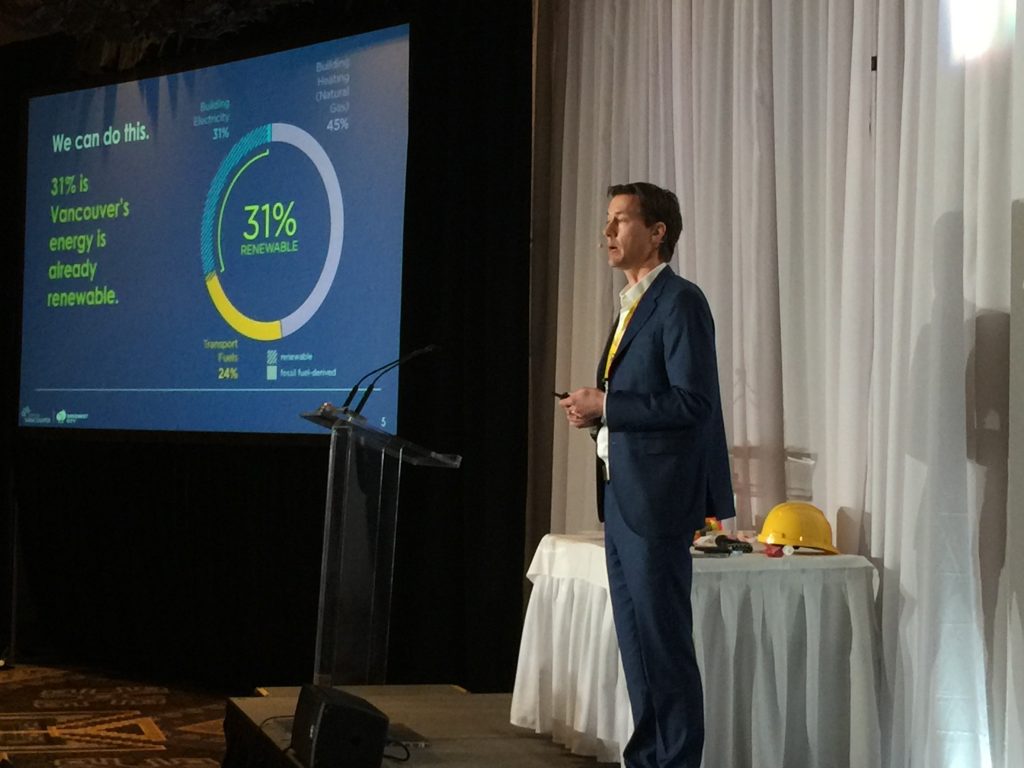Vancouver is pushing the envelope for reducing building emissions.
City of Vancouver assistant director of sustainability Brad Badelt looked at the present and future of the city’s Zero Emissions Building Plan at a session held at the Vancouver Regional Construction Association’s recent Construction Leadership Forum in Whistler, B.C.
The City of Vancouver was the first to adopt targets of 100 per cent energy use from renewable sources before 2050 and a reduction of gas emissions by 80 per cent below 2007 levels before 2050 when it implemented the Zero Emissions Building Plan in 2016.
“Vancouver has always had a pretty strong building code and building environment in terms of the stakeholders in the region,” Badelt said. “We probably took the first steps in the zero emissions plan, but the province was really quick to get in with the BC Energy Step Code, and I think the strength is that the Step Code and our plan really mirror each other and there’s consistency from municipality to municipality as we go forward, which is fantastic.”
Several zero emissions projects are in the works, he added, including the city’s first passive house fire hall.
“We have eight projects going through the design and construction, including a fire hall that I think is the first passive house fire hall in Canada. It’s a small step forward but by the city demonstrating leadership and sharing those learnings it’s a way of accelerating that change,” he said.
He added with almost 30 rezoning applications in the past year, six of those projects have voluntarily moved forward with passive house-like approaches.
“One of the biggest is two passive house towers on Alberni Street, 48 storeys and 43 storeys. If they go through the rezoning process successfully and acquire building permits, they will be the two tallest passive house projects in the world, more than double the next tallest,” Badelt said.
New and newer buildings are the focus for lowering emissions, he added, because fixing new buildings is easier than retrofitting older structures.
“The faster we can fix new buildings, the less retrofitting we have to do,” he said.
While 44 per cent of new construction in Vancouver is still single-family buildings, he said, highrises and commercial buildings are a significant portion of construction and those buildings is where the most change can take place.
“We’re well ahead of other regions and have a really low greenhouse gas footprint, in part because our electricity is largely hydro instead of coal-fired. We have a dense city with a lot of walking and cycling, and a relatively affluent region compared to the rest of the world. Those are all opportunities to build on and position the building industry as a leader,” Badelt said.
A recently announced Zero Emissions Building Centre of Excellence will help push forward the adoption of zero emissions standards, he added.
“It’s a project we’re really excited about and it’s meant to bring together builders, designers and developers to share information, to help us craft better regulations, share successes and challenges and advance the plan along,” Badelt said.
Vancouver Regional Construction Association president Fiona Famulak’s organization is a key stakeholder in the centre, and she thanked the city for their vision and for the goals set by the Zero Emissions Building Plan.
“By 2025 all new commercial and residential buildings will be built to zero emission standards. That’s only seven years away, so we have some work in the industry to build capacity. By virtue of the city’s funding, we’ll be hosting the Zero Emissions Centre for Excellence, which is the first in Canada,” Famulak said.
Beyond current practices, there are new techniques on the horizon to further reduce emissions, Badelt said.
“Probably the big one is embodied carbon. Historically, policy around buildings has focused on the operations of the building because that was the bulk of the energy going in and emissions coming out,” he said.
“As we advance the performance of the buildings, operating emissions are going down and the energy that goes into constructing the structure becomes a bigger factor and bigger proportion of the overall life cycle.”
As time goes on more attention will be placed on reducing these embodied emissions, he said, and part of that process will be bringing the supply chain closer to Vancouver.
“We shouldn’t be relying on windows from Europe or other parts from across the country. We should be bringing those suppliers into the region and becoming a North American supplier versus us bringing in supplies from far away,” Badelt said.











Recent Comments